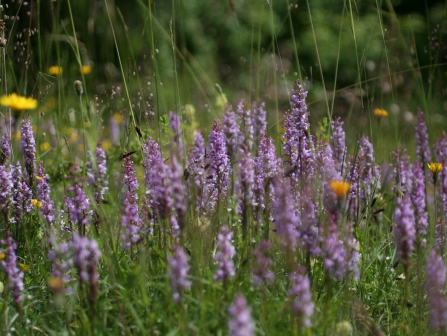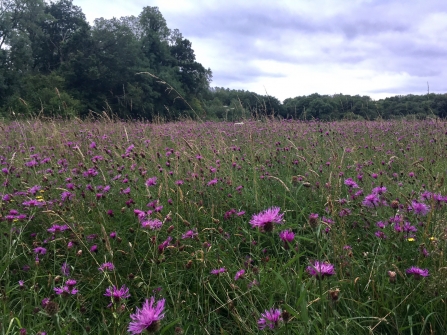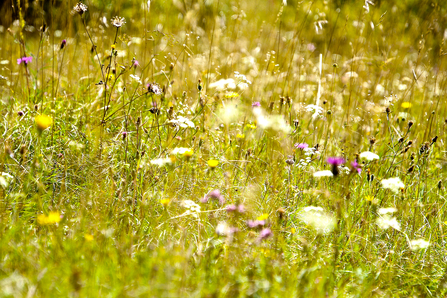
Wild flowers at Asham Meads. Photo by Colin Williams
A meadow of knapweed at Moor Copse by Roger Stace

Wild flowers at Asham Meads. Photo by Colin Williams
A lovely expanse of grassland, Asham Meads is full of colour in summer. The meadows were once ploughed into ridges and furrows, which give long strips of colour from the different plants that grow on them. The ridges of the north-eastern field are covered by maroon flowers of great burnet, dropwort and meadow foxtail grass. Nestling in the wetter furrows are marsh-loving plants, such as ragged-robin and the uncommon tubular water-dropwort.
On the ridges of Upper and Lower Marsh you will find common knapweed and traditional meadow grasses crested dog's-tail and sweet vernal-grass. Among the panorama of flowers are pepper-saxifrage, yellow rattle, and saw-wort.
There's plenty of insect and birdlife here too with butterflies including marbled white, and skylarks singing high overhead.

Tucked away on the edge of Wendover Woods between Aylesbury and Tring, Aston Clinton Ragpits is a remarkable nature reserve. Just three hectares in size yet boasting eight species of orchid and over 25 different types of butterfly, this reserve offers a real treat to visitors in spring and summer.
Towards the end of June you can enjoy a spectacular display of orchids which includes greater butterfly-orchid, pyramidal orchid and thousands of fragrant orchids with their deep pink, clove-scented flowers.

Helen Dewar
Take a detour from a walk along the Thames Path to visit Hartslock, near Goring-on-Thames. Bee, pyramidal and common spotted-orchids, common twayblade and white helleborine grow on this sloping grassland and long with many other wild flowers. The reserve is also excellent for insects, featuring a variety of bee species, uncommon shieldbugs, grasshoppers and day-flying moths.
Butterflies include the lovely chalkhill blue, green hairstreak and grizzled skipper. The occasional visit by the rare Adonis blue adds a further splash of colour with the brilliant turquoise-blue of the male butterfly.

A meadow of knapweed at Moor Copse by Roger Stace
This diverse woodland wildlife treasure trove astride the River Pang is a haven of peace and beauty, renowned for its flowers, butterflies and moths. In summer, butterflies are abundant and the meadows are brimming with wild flowers. Dragonflies and damselflies, such as the beautiful demoiselle and the brown hawker hunt up and down the river.
Moor Copse is one BBOWT’s most charismatic wildflower meadows which have been named Coronation Meadows. The Coronation Meadows project celebrates the historic and extraordinary diversity of meadows, and encourages the creation of many more in the next 60 years through seeds and green hay from the Coronation sites.

Padworth Common is a tranquil haven for wildlife with heathland, woodland, ponds and alder-lined gullies. During the summer months the heath buzzes with activity. Look for butterflies including the elusive grayling use the heath. It is hard to spot on gravelly areas basking with wings closed and tilted in a peculiar fashion.
A lovely way to while away half an hour or so is to sit near the main pond on North Common and enjoy the darting dragonflies and damselflies.
There are ground-nesting birds and reptiles here so please stick to the paths to help protect these species.

Yoesden nature reserve by Jacqui Titcombe
Yoesden is home to an impressive variety of butterflies. It is considered by many as one of the jewels of the Chilterns Area of Outstanding Natural Beauty for the numbers of butterflies found on site. 28 species have been recorded, including three scarce blue species: Adonis, chalkhill and small blue butterflies, all of which rely on the flower-rich grassland that makes up about half of the reserve.
Yoesden is equally important for chalk downland plants. Towards the end of June parts of the bank are pink with amazing shows of common spotted and fragrant orchids laced with the vivid yellow of bird's-foot trefoil, horseshoe vetch and kidney vetch - all plants so important for the butterfly species found here.